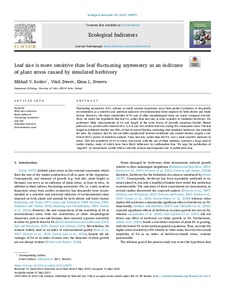Leaf size is more sensitive than leaf fluctuating asymmetry as an indicator of plant stress caused by simulated herbivory
Kozlov Mikhail V; Zvereva Elena L; Zverev Vitali
Leaf size is more sensitive than leaf fluctuating asymmetry as an indicator of plant stress caused by simulated herbivory
Kozlov Mikhail V
Zvereva Elena L
Zverev Vitali
ELSEVIER
Julkaisun pysyvä osoite on:
https://urn.fi/URN:NBN:fi-fe2022081153820
https://urn.fi/URN:NBN:fi-fe2022081153820
Tiivistelmä
Fluctuating asymmetry (FA), defined as small, random departures away from perfect symmetry, is frequently recommended as a sensitive and universal indicator of environmental stress imposed by both abiotic and biotic factors. However, the stress sensitivities of FA and of other morphological traits are rarely compared directly. Here, we tested the hypothesis that leaf FA, rather than leaf size, is more sensitive to simulated herbivory. We performed blind measurements of FA and length of the same leaves of juvenile mountain birches (Betula pubescens var. pumila) after removal of 0, 2, 4, 8 and 16% of their leaf area during five consequent years. The leaf length in defoliated birches was 88% of that in control birches, indicating that simulated herbivory was stressful for trees. By contrast, leaf FA did not differ significantly between defoliated and control birches, despite a sufficient (91%) power of statistical analysis. Thus, leaf size, rather than leaf FA, was a more sensitive indicator of stress. This low sensitivity of FA to stress, discovered with the use of blind methods, contrasts a large pool of earlier studies, many of which have been likely influences by confirmation bias. We urge the publication of 'negative' or inconclusive results which currently remain underreported due to publication bias.
Kokoelmat
- Rinnakkaistallenteet [19207]
